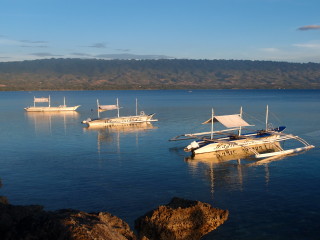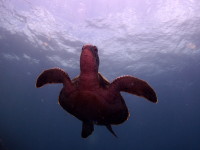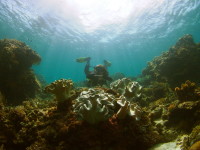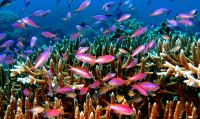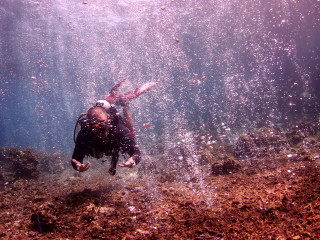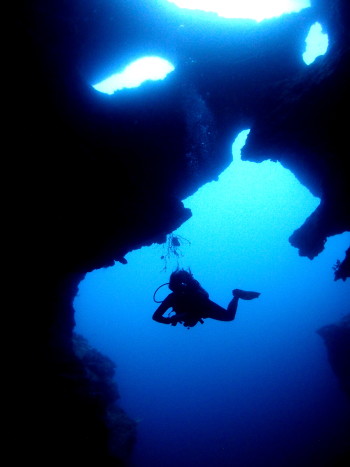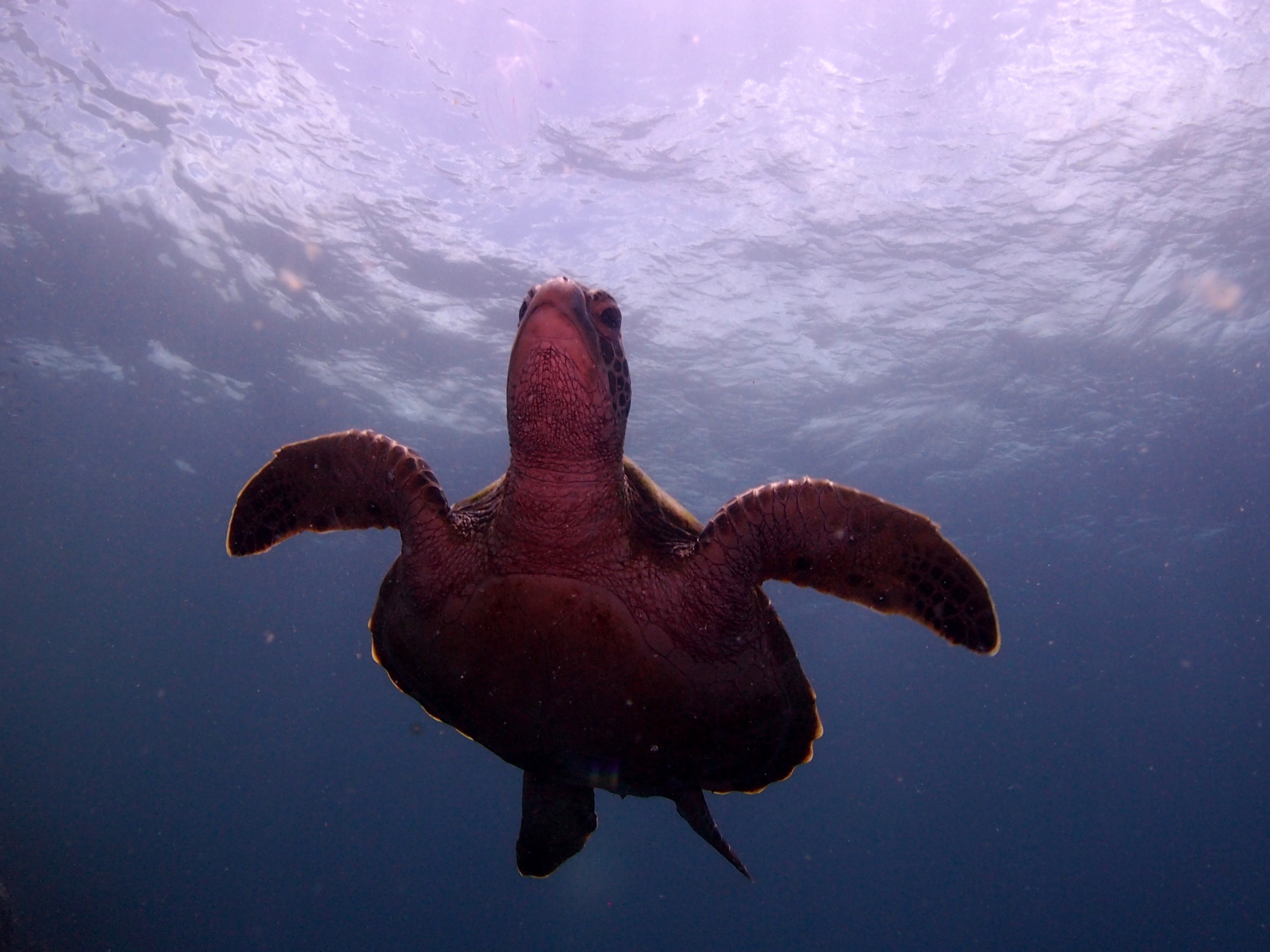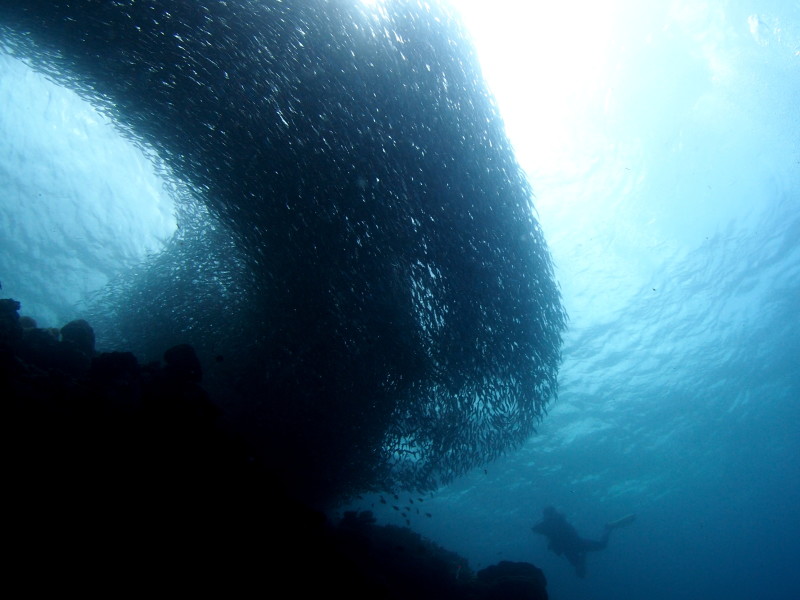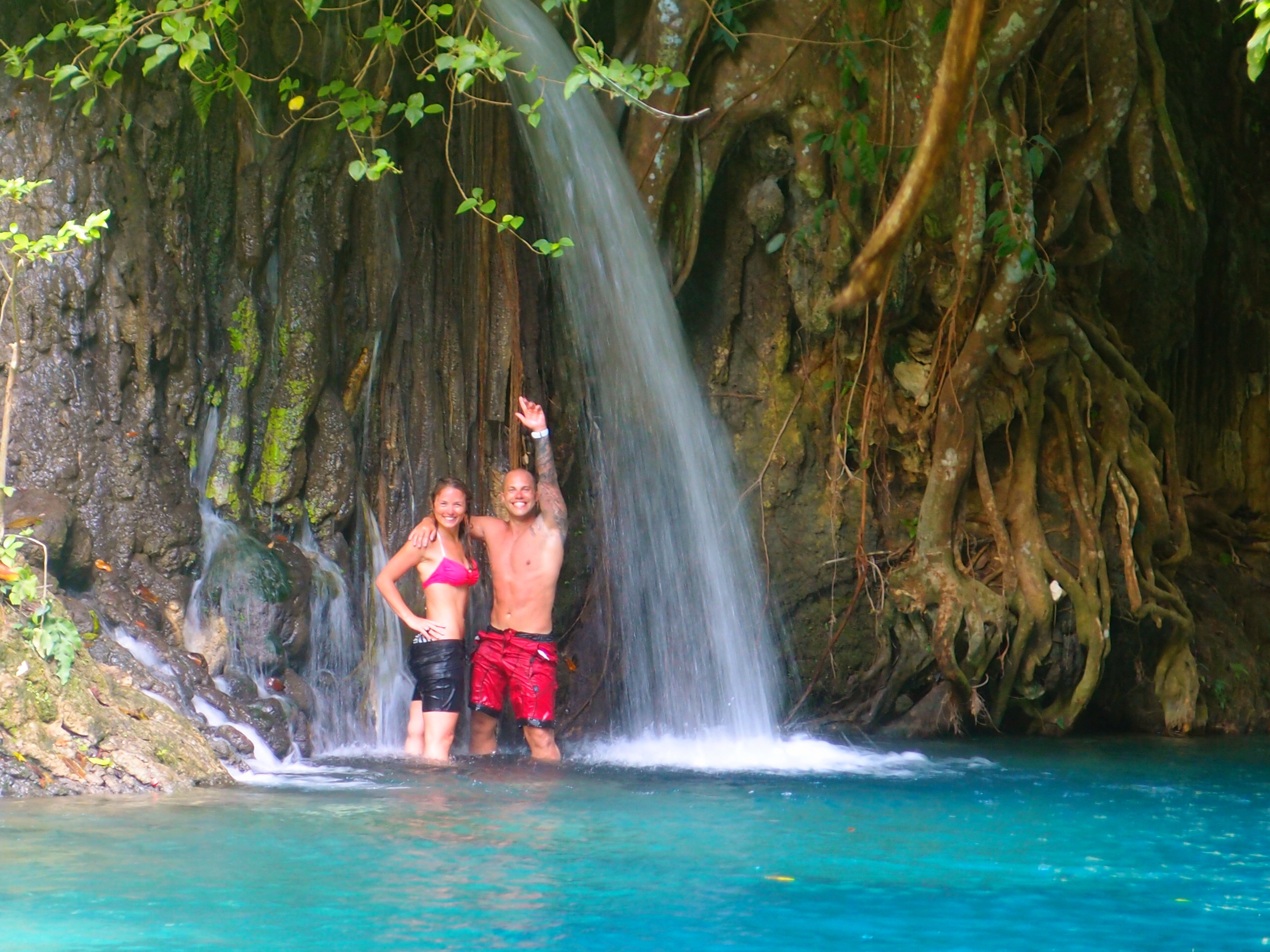News
Mat’s Philippines Trip 2015: Part 4
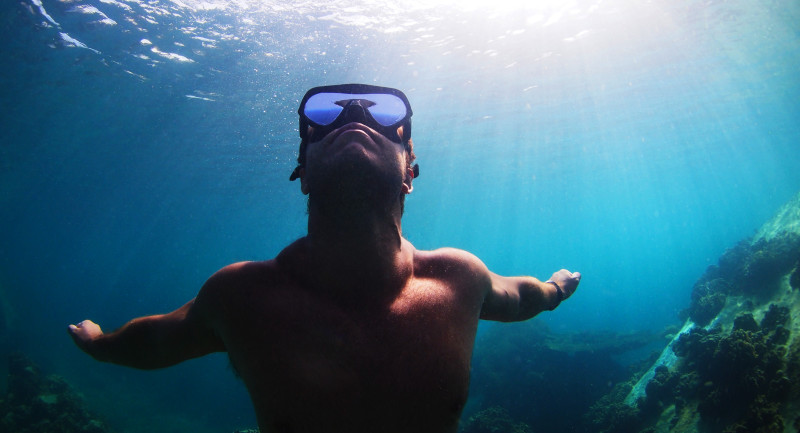
Read Part 1 here. Read Part 2 here. Read Part 3 here.
Magic Island
It wasn’t difficult coming up with a title for the final instalment of my Philippines trip report. The resort we spent our last few days at is evocatively called Magic Island; located in a beautifully calm bay in Moalboal on the island of Cebu it is a peaceful and tranquil place. We arrived after dark and enjoyed a lovely alfresco dinner overlooking the sea; the water was so flat it could have been a lake reflecting the shining stars and moonlight overhead. We instantly fell in love with our intimate and charming new home and after a long day of travel on public boats and buses from Malapascua we hit the sack ahead of our first dives in the morning.
Magic Island Bay by night and by day – a peaceful place.
Before breakfast I had a wander around the resort, this time with the help of the glorious sunlight rather than subtle outdoor mood lighting. Ten traditional thatched style bungalows make up Magic Island along with a small pool, open air bar and plenty of spots to sit and enjoy the views of the bay. Across the water is Moalboal’s very own chocolate hills; Bohol is the island famed for having so called chocolate hills but the scenic back drop here is every bit as beautiful. After a hearty plateful of scrambled eggs and toast it was time to prepare our gear for the first dive of the day. There was a Belgian dive club who dominated the resort while we were there, a friendly bunch but we kept ourselves to ourselves mostly – we even had our own boat just for the two of us. The equipment area is spacious and well thought out with personal hangers and boxes for all your gear. I was excited to discover that Pescador Island was first up on the agenda – widely regarded as one of the best sites in the area…not a bad start.
A short 10-15 minute boat ride away, Pescador Island can be seen from the bay. A huge bait ball of sardines used to take up residence around Pescador but they have since moved. Fortunately for us they simply moved to another local dive site and so we hoped to dive amongst them at some stage. If I’m completely honest I had set my expectations pretty low with regards to the diving. Moalboal is not known for encounters with the ‘big guys’ of the ocean and my understanding until now was that the dive sites are somewhat modest to put it politely. Well I have to say that I thoroughly enjoyed Pescador. The shallow reef that encrusts the island is filled with pristine hard coral and countless Anthias – the goldfish of the sea – have made it their home. My first thought was quite simply “well this is very pretty”. The sunlight pierced the surface of the water and making our way from the shallows to begin our descent along the wall was like cruising through a giant aquarium.
The clear waters and healthy reefs make Moalboal like diving in an aquarium.
We reached a depth of around 40m in the hopes to catch a glimpse of the white tip sharks that usually lurk there but they didn’t come out to play unfortunately. As we circled the island hugging close to the wall we made our ascent within a wide vertical swim thru called ‘The Cathedral’. It has a number of window-like openings, and looked less like a Cathedral and more like the carved features of a Halloween pumpkin. An abundance of fish life inhabit the dive site which probably attributes to its name – translated from Spanish, Pescador simply means ‘fisherman’. Our safety stop was spent playing in the bubbles that escaped from the fissures of the rock – I’m not sure if these bubbles were from divers in the swim thru below or whether they are produced from some kind of volcanic activity but I expect it was simply divers (I should have asked!).
We only had 4 nights at Magic Island with two days of diving – I wish we could have stayed for longer. The order of the day is wall diving in Moalboal; the clear water and healthy reefs make for very pleasant experiences underwater. We saw an astonishing number of turtles, nine on a single dive in fact. Some were very bold and quite content to pose for a close up; clearly familiar with bumping into divers on a regular basis. We took to the water after dark on our second day to see what the house reef had to offer on a night dive. Rather than taking a guide we navigated the simple site ourselves; 30 minutes one way, turn around and 30 minutes back. As we always do we spent the second half of the dive with our torches off enjoying the natural environment without the intrusiveness of an artificial beam of light. When we came across a group of four divers searching for critters along the face of the wall with their underwater lightsabers we swooped beneath them – unseen like aqua ninjas! If you haven’t dived this way before I highly recommend it if you really want to immerse yourself in the experience.
An abundance of turtles are as good as guaranteed in Moalboal
Remember the bait-ball of sardines that disappeared from Pescador Island? Luckily they didn’t make it very far. Just 10 minutes or so away from the resort and close to shore is a dive site called Panagsama Beach and it is here where the huge cluster of tiny fish have decided to set up camp. We intended to spend 10 minutes or so playing amongst them and snapping a few pictures but actually we ended up spending a full hour mesmerised by them. The ball tends to stay within about 5m of the surface and never seems to drop below 12m or so; it makes for a fun dive and some interesting photos so I’d definitely factor it in.
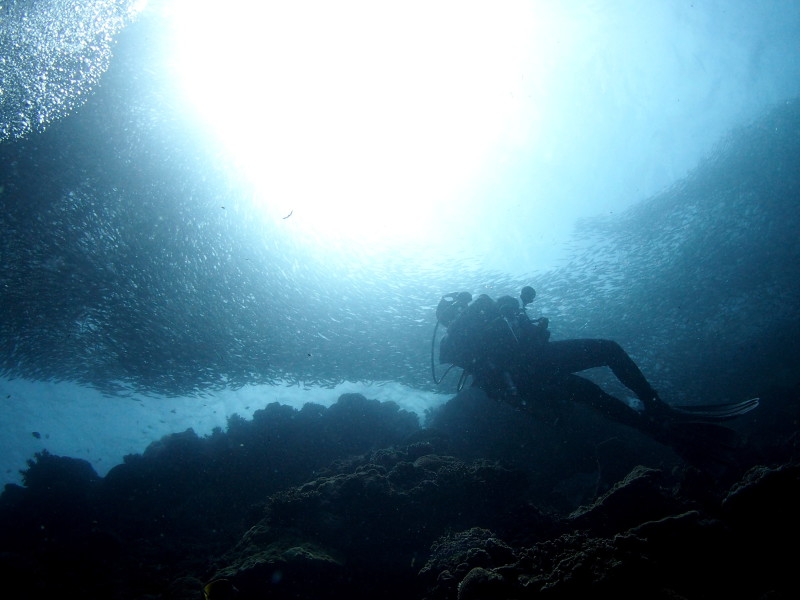 The sardines that hang out at Panagsama Beach are great fun to dive with
The sardines that hang out at Panagsama Beach are great fun to dive with
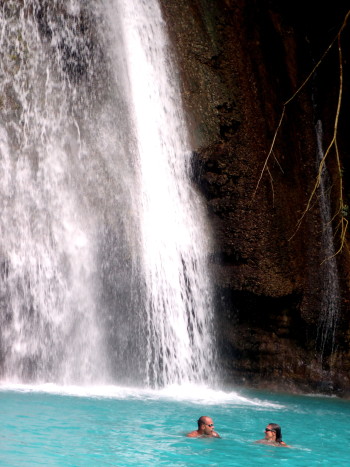 Our last day was spent out of the water, well…out of the sea at least. We drove 45 minutes or so to Kawasan Falls; a beautiful place with a number of waterfalls. It’s possible to climb up to 6 different stages and there are a number of opportunities to jump in the pools below from heights that some may find unsettling. The local people will often visit the falls to cool down and enjoy a swim; the children show no fear as they perform hair raising back-flips from the highest of jumping points – truly nosebleed worthy! It was a great afternoon and well worth the visit.
Our last day was spent out of the water, well…out of the sea at least. We drove 45 minutes or so to Kawasan Falls; a beautiful place with a number of waterfalls. It’s possible to climb up to 6 different stages and there are a number of opportunities to jump in the pools below from heights that some may find unsettling. The local people will often visit the falls to cool down and enjoy a swim; the children show no fear as they perform hair raising back-flips from the highest of jumping points – truly nosebleed worthy! It was a great afternoon and well worth the visit.
An exhilarating dip in the Kawasan Waterfalls makes for a refreshing change from diving.
It wasn’t long before our time in Moalboal had come to an end, and to make matters worse this also signalled the end of our trip altogether! Just 3 flights, a night in Manila and 35 hours later and we would be tucked up in our own beds. Island hopping in the Philippines makes for a truly amazing itinerary; the diving opportunities are rich and varied providing encounters with critters both great and small. If you haven’t read the previous instalments to this article (or you have but could do with a re-cap) here are some quick ‘hashtag’ highlights of the 13 blissful days we spent in the stunningly beautiful seven thousand (plus!) island country that is the Philippines.
#sogodbay #whalesharks #sunsets #threshersharks #happyhour #hammerheads #mantas #matingmandarin #sambawanisland #sardines #octopus #gatoisland #kawasanfalls #whitetipsharks #padresburgos #nightdives #sogod2malapascua2moalboalin2weeks
Seeing it on paper like that makes me want to do it all over again!
If you would like to know more about planning an island hopping diving holiday in the Philippines then you can contact Mat at Dive Worldwide where he works as a Dive Specialist Consultant.
Blogs
Northern Red Sea Reefs and Wrecks Trip Report, Part 3: The Mighty Thistlegorm

Jake Davies boards Ghazala Explorer for an unforgettable Red Sea diving experience…
Overnight, the wind picked up, making the planned morning dive a bit bumpy on the Zodiacs to the drop point on Thomas Reef. There, we would dive along the reef before descending through the canyon and then passing under the arch before ascending the wall with a gentle drift. The site provided great encounters with more pelagic species, including shoals of large barracuda, tuna, and bigeye trevally.
Once back on the boat, it was time to get everything tied down again as we would head back south. This time, with the wind behind us, heading to Ras Mohammed to dive Jackfish Alley for another great gentle drift wall dive before then heading up the coast towards the Gulf of Suez to moor up at the wreck of the Thistlegorm. This being the highlight wreck dive of the trip and for many onboard, including myself, it was the first time diving this iconic wreck. I had heard so much about the wreck from friends, and globally, this is a must on any diver’s list. Fortunately for us, there was only one other boat at the site, which was a rarity. A great briefing was delivered by Ahmed, who provided a detailed background about the wreck’s history along with all the required safety information as the currents and visibility at the site can be variable.

Kitting up, there was a lot of excitement on deck before entering the water and heading down the shoreline. Descending to the wreck, there was a light northerly current which reduced the visibility, making it feel more like the conditions that can be found off the Welsh coast. At 10m from the bottom, the outline of the wreck appeared as we reached the area of the wreck which had been bombed, as our mooring line was attached to part of the propeller shaft. Arriving on deck, instantly everywhere you looked there were many of the supplies which the ship was carrying, including Bren Carrier tanks and projectiles that instantly stood out.

We headed around the exterior, taking a look at the large propeller and guns mounted on deck before entering the wreck on the port side to take a look in the holds. It was incredible to see all the trucks, Norton 16H, and BSA motorcycles still perfectly stacked within, providing a real snapshot in time.

Overall, we had four dives on the Thistlegorm, where for all of the dives we were the only group in the water, and at times, there were just three of us on the whole wreck, which made it even more special, especially knowing that most days the wreck has hundreds of divers. Along with the history of the wreck, there was plenty of marine life on the wreck and around, from big green turtles to batfish, along with shoals of mackerel being hunted by trevally. Some unforgettable dives.

The final leg of the trip saw us cross back over the Suez Canal to the Gobal Islands where we planned to stay the night and do three dives at the Dolphin House for the potential of sharing the dive with dolphins. The site, which included a channel that was teeming with reef fish, especially large numbers of goatfish that swam in large shoals along the edge of the reef. These were nice relaxing dives to end the week. Unfortunately, the dolphins didn’t show up, which was okay as like all marine life they are difficult to predict and you can’t guarantee what’s going to be seen. With the last dive complete, we headed back to port for the final night where it was time to clean all the kit and pack before the departure flight the next day.

The whole week from start to finish on Ghazala Explorer was amazing; the boat had all the facilities you need for a comfortable week aboard. The crew were always there to help throughout the day and the chefs providing top quality food which was required after every dive. The itinerary providing some of the best diving with a nice mixture of wreck and reef dives. I would recommend the trip to anyone, whether it’s your first Red Sea liveaboard in the Red Sea or you’re revisiting. Hopefully, it’s not too long before I head back to explore more of the Red Sea onboard Ghazala Explorer.

To find out more about the Northern Red Sea reef and wrecks itineraries aboard Ghazala Explorer, or to book, contact Scuba Travel now:
Email: dive@scubatravel.com
Tel: +44 (0)1483 411590
Photos: Jake Davies / Avalon.Red
Blogs
Northern Red Sea Reefs and Wrecks Trip Report, Part 2: Wall to Wall Wrecks

Jake Davies boards Ghazala Explorer for an unforgettable Red Sea diving experience…
The second day’s diving was a day full of wreck diving at Abu Nuhas, which included the Chrisoula K, Carnatic, and Ghiannis D. The first dive of the day was onto the Chrisoula K, also known as the wreck of tiles. The 98m vessel remains largely intact where she was loaded with tiles which can be seen throughout the hold. The stern sits at 26m and the bow just below the surface. One of the highlights of the wreck is heading inside and seeing the workroom where the machinery used for cutting the tiles are perfectly intact. The bow provided some relaxing scenery as the bright sunlight highlighted the colours of the soft coral reef and the many reef fish.

Following breakfast, we then headed to the next wreck, which was the Carnatic. The Carnatic is an 89.9m sail steamer vessel that was built in Britain back in 1862. She ran aground on the reef back in 1869 and remains at 27m. At the time, she was carrying a range of items, including 40,000 sterling in gold. An impressive wreck where much of the superstructure remains, and the two large masts lay on the seafloor. The wooden ribs of the hull provide structures for lots of soft corals, and into the stern section, the light beams through, bouncing off the large shoals of glass fish that can be found using the structure as shelter from the larger predators that are found outside of the wreck.

The final wreck at Abu Nuhas was the Ghiannis D, originally called ‘Shoyo Maru,’ which was 99.5m long and built in Japan back in 1969 before becoming a Greek-registered cargo ship in 1980. The ship then ran aground on the reef on April 19th, 1983, and now sits at the bottom at a depth of 27m. Heading down the line, the stern of the ship remains in good condition compared to the rest of the hull. The highlight of the wreck, though, is heading into the stern section and down the flights of stairs to enter the engine room, which remains in good condition and is definitely worth exploring. After exploring the interior section of the ship, we then headed over to see the rest of the superstructure, where it’s particularly interesting to see the large table corals that have grown at the bow relatively quickly considering the date the ship sank. After surfacing and enjoying some afternoon snacks, we made sure everything was strapped down and secured as we would be heading north and crossing the Gulf of Suez, where the winds were still creating plenty of chop.

The next morning, it was a short hop to Ras Mohammed Nature Reserve for the next couple of days of diving. The 6am wake-up call came along with the briefing for the first site we would be diving, which was Shark & Yolanda. The low current conditions allowed us to start the dive at Anemone City, where we would drift along the steep, coral-filled wall. These dives involved drifts, as mooring in Ras Mohammed wasn’t allowed to protect the reefs. As a dive site, Shark & Yolanda is well-known and historically had a lot of sharks, but unfortunately not so many in recent years, especially not so early in the season. However, there was always a chance when looking out into the blue.

The gentle drift took us along the steep walls of the site, with plenty of anemone fish to be seen and a huge variety of corals. It wasn’t long into the dive before we were accompanied by a hawksbill turtle, who drifted with us between the two atolls before parting ways. Between the two reefs, the shallow patch with parts of coral heads surrounded by sand provided the chance to see a few blue-spotted stingrays that were mainly resting underneath the corals and are always a pleasure to see. With this being the morning dive, the early sunlight lit up the walls, providing tranquil moments. Looking out into the blue, there was very little to be seen, but a small shoal of batfish shimmering underneath the sunlight was a moment to capture as we watched them swim by as they watched us.

Towards the end of the dive, we stopped at the wreck of the Jolanda where the seafloor was scattered with toilets from the containers it was carrying. This provided a unique site to make a safety stop, which was also accompanied by a large barracuda slowly swimming by, along with a hawksbill turtle calmly swimming over the reef as the sun rays danced in the distance.
For the next dive, we headed north to the Strait of Tiran to explore the reefs situated between Tiran Island and Sharm El Sheik, which were named after the British divers who had found them. We started on Jackson before heading to Gordons Reef, where we also did the night dive. All the atolls at these sites provided stunning, bustling coral reefs close to the surface and steep walls to swim along, which always provided the opportunity to keep an eye out for some of the larger species that can be seen in the blue. Midwater around Jackson Reef was filled with red-toothed triggerfish and shoals of banner fish, which at times were so dense that you couldn’t see into the blue. Moments went by peacefully as we enjoyed the slow drift above the reef, watching these shoals swim around under the mid-afternoon sun.

The night dive at Gordon’s Reef was mainly among the stacks of corals surrounded by sand, which was great to explore under the darkness. After some time circling the corals, we came across what we were really hoping to find, and that was an octopus hunting on the reef. We spent the majority of the dive just watching it crawl among the reef, blending into its changing surroundings through changes in colour and skin texture. It’s always so fascinating and captivating to watch these incredibly intelligent animals, in awe of their ability to carry out these physical changes to perfectly blend into the reef. Before we knew it, it was time to head back to the boat to enjoy a well-deserved tasty dinner prepared by the talented chefs onboard.
Check in for the 3rd and final part of this series from Jake tomorrow!
To find out more about the Northern Red Sea reef and wrecks itineraries aboard Ghazala Explorer, or to book, contact Scuba Travel now:
Email: dive@scubatravel.com
Tel: +44 (0)1483 411590
Photos: Jake Davies / Avalon.Red
-

 News3 months ago
News3 months agoHone your underwater photography skills with Alphamarine Photography at Red Sea Diving Safari in March
-

 News3 months ago
News3 months agoCapturing Critters in Lembeh Underwater Photography Workshop 2024: Event Roundup
-

 Marine Life & Conservation Blogs2 months ago
Marine Life & Conservation Blogs2 months agoCreature Feature: Swell Sharks
-

 Blogs2 months ago
Blogs2 months agoMurex Resorts: Passport to Paradise!
-

 Blogs2 months ago
Blogs2 months agoDiver Discovering Whale Skeletons Beneath Ice Judged World’s Best Underwater Photograph
-

 Gear Reviews3 months ago
Gear Reviews3 months agoGear Review: Oceanic+ Dive Housing for iPhone
-

 Marine Life & Conservation2 months ago
Marine Life & Conservation2 months agoSave the Manatee Club launches brand new webcams at Silver Springs State Park, Florida
-

 News3 months ago
News3 months agoWorld’s Best Underwater Photographers Unveil Breathtaking Images at World Shootout 2023



